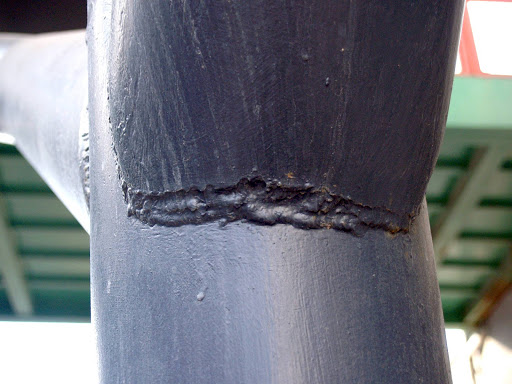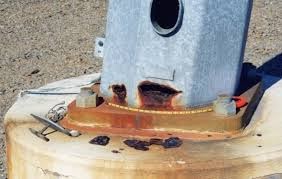About Street Light Poles: The Foundation of a Street LightPosted by Stephen Shickadance in Solar Lighting Design. Industry News..jpg)
Why Use Steel for a Solar Street Light Pole?For street light poles, steel is a better choice to have over aluminum for several reasons, the most important being different types of vibrations. There are two common types of vibrations in light poles known as first mode- and second mode- vibrations. First Mode Vibration in Street Light PolesThese vibrations are from the street light poles being hit with high winds that cause them to sway in the wind. These are typically minimal vibrations that are expected to come with the location and weather conditions of where the pole will reside. Second Mode Vibration in Street Light PolesSecond-mode vibrations, or Aeolian vibrations, refer to a more destructive force. They’re caused from higher-velocity winds that can inflict audible structural damage to the mid-section of the pole. Too much exposure to Aeolian vibrations can cause cracks or damaged fixtures. Aluminum is known to suffer greater damage under Aeolian vibrations when compared to steel, which is why the best quality solar lights are manufactured with steel poles. Warped Light PolesIn addition to damaging vibrations, aluminum tends to warp at high temperatures. Since solar lights are intended to sit in the sun for long periods of time every day, aluminum is not a great choice. Steel is more heat resistant to warping in extreme temperatures. Solar Street Light Poles: What’s Your Steel Made Of?Common steel standards adhere to the Q235 (China) or the ASTM-GR65 (US) standard. Q235 is carbon-heavy and often used in bridges. The “Q” in the name refers to the yield point which is 235 MPa or Megapascals of pressure. There are many more qualities to this type of steel than what are covered here. Check this resource to learn more about Q235 steel. Effective Projected AreaIt’s also important to recognize what size of pole you’re purchasing. Proper solar light poles adhere to a calculation called Effective Projected Area (EPA), which determines the amount of force a pole receives from the solar lighting components and wind velocity of where it resides. EPAs must be determined by qualified structural engineers that can sign off on a project before the poles are erected. If the calculations are incorrect, it’s entirely possible the weight of the light fixture and solar components are too much for the pole, and you’ll lose your entire light--at least. This comes into play in regards to retrofitting solar lights to older poles. The pole size is a large factor in determining EPA--standard street pole sizes are between 25 and 30 feet, whereas pathway poles tend to be 12 to 20 feet. Hot-Dip GalvanizationBefore street light poles are ready to be shipped, they go through a process called hot-dip galvanization which coats the pole in a thick layer of zinc and other substances. Galvanization prevents the pole from rusting--which is necessary if you want the pole to last for its lifespan. Not all galvanization processes are the same, however. Some manufacturers, to cut corners, will use cold-dip galvanization which is not as effective. HDG dips the steel pole into molten zinc heated up to approximately 840°F (449°C). The advantage here is the zinc turns to zinc carbonate and forms a chemical bond to the steel. CDG is a simpler process where the pole is painted with a layer of zinc-based paint. This forms a mechanical bond to the steel, but isn’t as effective as HDG because the layer of zinc paint can wear off over time from weather and abrasion. In addition to long-term anti-rust protection, HDG gives the solar street light pole a sleek, industrial look. Why not protect a pole and make it look attractive at the same time? Powder Coating Light PolesThe last quality process is powder coating where the steel poles are electrostatically sprayed with a variety of substances in order to give the pole a durable finish. Other methods of applying a finish to the solar street light pole release pollutants called Volatile Organic Compounds (VOCs). A powder finish is the best option since it’s environmentally friendly and less expensive than other methods. If you’re purchasing solar lights to be environmentally conscious, then ensure your manufacturer uses a powder coating instead of more hazardous methods of pole finishing. Light Poles are Only as Good as their FoundationA solar light needs a strong foundation. Before installation, concrete pedestals are poured and left to dry before the pole can be erected. A 4-foot deep pedestal is common, but sometimes due to the pole length and EPA a 6-foot deep pedestal must be set before the pole goes up. For obvious reasons, we wouldn’t recommend using a pedestal of less than 4 feet deep. What You Don’t Want in a Street Light Pole Here are some examples of poles that were clearly not manufactured with the right materials.
ConclusionIt’s clear that the wrong pole can spell a short lifespan for your solar light. Proper materials, the best manufacturing methods, and the right kind of metal treatment will make sure your solar light pole will outlast all other components--or else your project could end up like the images above.
Solar Lighting Design
Industry News
|
ArchivesNo Archives Categories
Want More Info? |
LATEST NEWS & ARTICLES





